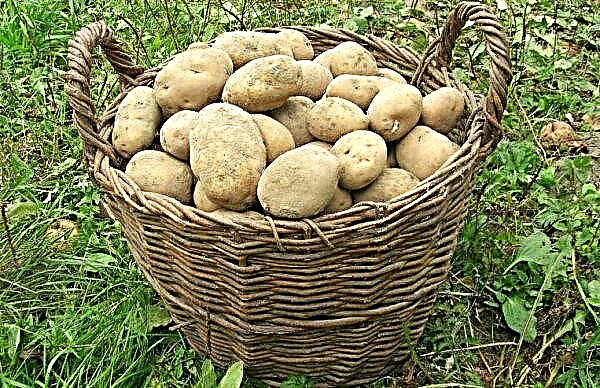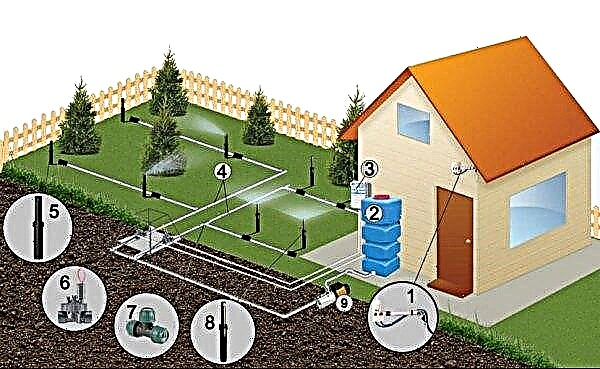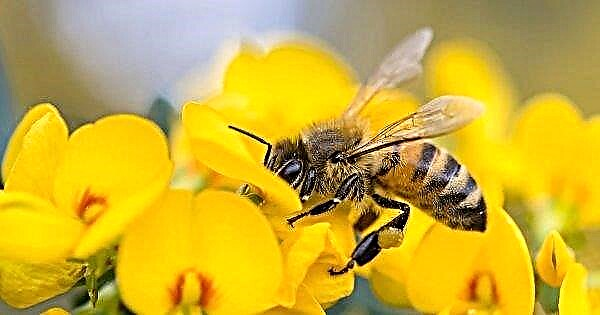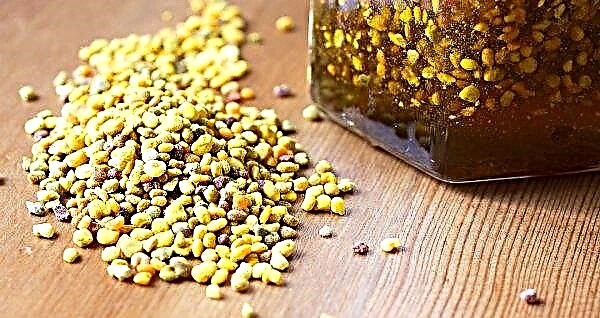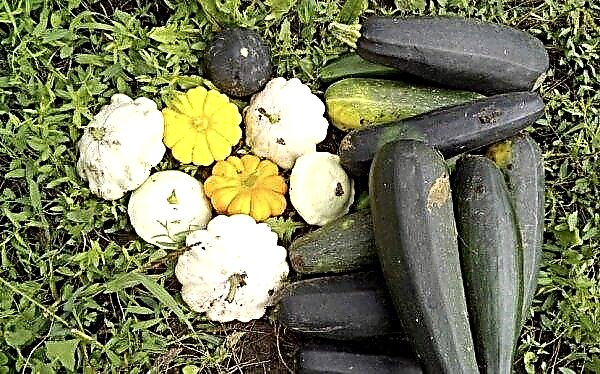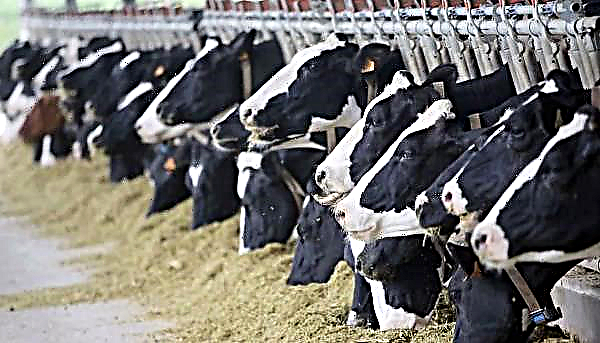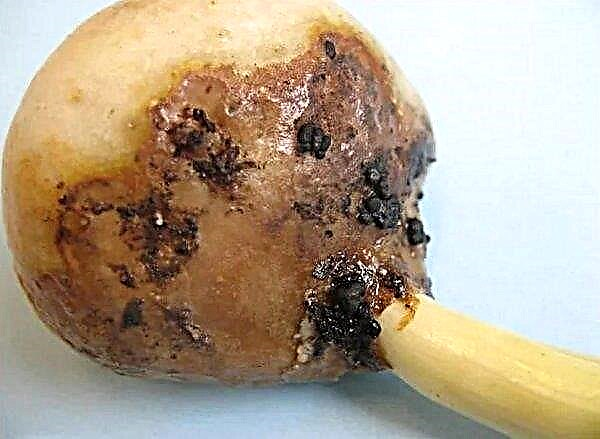Among all the abundance of bee products, uterine milk is considered one of the most unique. This substance is particularly nutritious, as well as a whole range of healing substances. However, not every beekeeper resorts to product extraction - this process is not only lengthy, but also requires special skills. The article discusses the subtleties of collecting royal jelly, and also reveals the main secrets of its proper storage.
The process of the appearance of royal jelly
Royal jelly means a special composition of feed used by working bees to feed uterine larvae. The substance is produced by the so-called bee-nurse - they are simple working bees focused on feeding queen cells. Milk is formed in the maxillary gland of insects, from which it is extracted into a honeycomb with larvae.
Milk is formed in the maxillary gland of insects, from which it is extracted into a honeycomb with larvae.
This substance is a white or light creamy thick mass with a high pH level. Its basis is:
- water - 65%;
- proteins (albumin and globulins) - 10–20%;
- carbohydrates (sucrose, glucose, fructose) - 10–20%.

Among all kinds of dissolved compounds in the milk there are vitamins A, C, D, E, H, PP, group B, about 15 types of fatty acids, among which decenic, succinic, stearic and palmitic acids differ in the highest concentration.
Among the trace elements in the product were found:
- iron;
- sulfur;
- manganese;
- calcium;
- gold;
- chromium;
- silicon;
- nickel;
- silver;
- zinc;
- cobalt.
In addition, milk is also a source of pyruvic and lactic acid, sterols and acetylcholines.
Did you know? Bees are considered one of the oldest creatures on Earth. According to archaeological finds, this species was fully formed in the early Cretaceous period (about 100 million years ago).
- Due to this composition, the substance has the following properties:
- antiviral;
- bactericidal;
- anti-inflammatory;
- anti-aging;
- tonic;
- biostimulating;
- antiseptic;
- vasodilator;
- antitumor.
Body value
The production of bee milk is one of the most important and valuable sectors of the modern economy. The result is a substance that exceeds the quality of honey and other derivatives of beekeeping.
In their composition, milk proteins are almost identical to meat, milk, egg and other animal proteins, while their usefulness is several times greater in the presence of valuable substances and nutritional value.
- The use of the product makes it possible:
- normalize blood pressure and metabolism;
- improve appetite, digestion, as well as the condition of the joints;
- increase physical endurance and resistance to stress;
- reduce blood sugar, cholesterol and radioactive substances;
- stimulate blood formation, tissue and organ regeneration, physical activity;
- strengthen vision, memory and immune system;
- accelerate growth processes (in children), as well as the activity of the natural elimination of toxins.
 Often the product is used in cosmetology.
Often the product is used in cosmetology.
Its regenerative properties help improve the condition of the external integument, which prolongs youth and provides a healthy appearance. Also, the increased content of biotin in milk makes it possible to normalize the lack of hemoglobin in the blood, which successfully affects the elimination of dandruff, seborrhea, alopecia, dermatitis and brittle nails.
An indispensable product for improving the condition of pathologies of the oral cavity. A variety of extracts and products based on it are the best means for healing wounds and eliminating infections of the gums and adjacent tissues. At the same time, you can overcome the problem of diseases of the oral cavity for a long time, and also protect your teeth from aggressive effects.Important! Milk is produced by bees and for feeding working insects, but such a product is less saturated with all kinds of useful substances than uterine.
Does collecting milk harm bees?
Getting bee milk is a rather complicated process that affects the natural life in the hives.. For this reason, most beekeepers have a very rational question about whether the collection of the product will harm the bees. In most cases, the process brings no more difficulties for the bee family than harvesting honey. However, this statement is true only in the case of targeted equipment of the mother liquor to obtain the product.
For this, special honeycombs are installed with young and strong uterus capable of efficient reproduction. Separate families are created from them, which become the main source of matter. Collecting milk as a by-product from unprepared mother liquors can lead to starvation of insects.
Collecting milk as a by-product from unprepared mother liquors can lead to starvation of insects.Royal jelly calendar
Subject to all the features of the procedure, product collection is carried out throughout the season: from the moment the first honey is formed until the apiary is laid for wintering.
If you observe the correct turnover of the frames in the uterine hive, you can do this daily. However, in most cases, the selection is performed 1 time in 3 days. This is due to the fact that the maximum productivity of bees is observed when the larvae reach the age of 3-4 days: in this case, almost all cells within the framework will be filled with a valuable product.
The technology for royal jelly at home
In most cases, the selection of mother milk involves the implementation of periodic processes during which the production of the product is stimulated. In this case, special rules must be observed to ensure safety during the preparation of the substance, both for humans and insects.
How to assemble and what is needed for this?
The collection of royal milk includes 3 consecutive stages:
- preparation of special cells;
- creating a family and vaccinating larvae;
- selection of the product and its storage.
To collect royal jelly, the largest and healthiest family is selected in the apiary, which in the future should be focused solely on the development of the product. For this, it is transplanted into a separate hive for laying eggs and forming larvae. From the framework of the larvae (their age should be no more than 24 days), they are placed in bowls fixed on the slats of special frame structures. Bowls simulate bee cells, where milk will be deposited in the future. They can be made of wax, plastic or other materials. Perform procedures using a special plastic spatula.
After this, the bowls are set in the hive to the family. In this case, the bee should be removed or fenced with a special cage in the farthest part of the bee house. After 3-4 days, the frames are removed, and the bowls are carefully opened - each of them will contain a valuable substance. Its extraction is carried out using a special spoon or a medical syringe, of which they are transferred to the selected liquid in a common container. Next, new larvae are placed in the bowls, after which the process is repeated.
Video: collecting royal jelly
If it is supposed to harvest milk as the main product, a special place will be arranged in the bee house, which will serve as a kind of laboratory. It is thoroughly cleaned and creates special conditions with elevated temperature (+ 25 ° C) and humidity of about 90%, as well as twilight. Under such conditions, it is best to vaccinate the larvae and other operations.
In the future, at least 3 hives are prepared for milk collection. At each of them, the removal of the product is carried out for 15 days. To do this, the uterus is removed from one family, and frames with small bowls are placed in the nest, replacing and selecting milk in them every 3 days. After 15 days, the uterus is transplanted from the second hive into the first and left alone to fill the brood cells. In the second, milk is taken and then the uterus is placed in the third hive. Such a scheme makes it possible to carry out the collection without harm to insects, since during work with two hives the third one regains its strength over 30 days.
The basic rules for the effective production of royal jelly:
- at the time of larvae replanting, the uterus must be eliminated or enclosed by a cell;
- young bees are the most productive;
- insects should be provided with the necessary food supply, pollen and fresh pollen;
- during non-breeding periods, the hive should be well fed with sugar syrup at the rate of 500-1000 ml per family;
- the hive should be well insulated and artificially create conditions of crowding in them - this stimulates the laying of an abundance of queen cells by insects.
Collection Safety Rules
When collecting milk, you should adhere to general safety measures for working with bees. They include the use of a protective suit and mask, as well as a smoker to repel insects from the frames. This is a critical requirement., since milk extraction causes stress in bees, so they become especially aggressive.
In addition, when working with bees overexposure to general sanitary requirements. They provide work only in a clean suit and with pre-sterilized equipment - it is disinfected with an alcohol solution or boiled for 30 minutes. Also, when working, a gauze dressing on the oral cavity should be used to avoid breathing contact with insects and their products.
Important! Bees aggressively react to saturated odors, so before working with them it is forbidden to smoke, take alcohol, use perfume or excessively aromatic products to clean the body and clothes.
Proper storage
Royal jelly - A fairly valuable and whimsical product, therefore, they are suitable for storage with special painstakingness. The main threat to this substance is direct sunlight, so all work, as well as storage, is carried out in twilight or fully protected from excessive sunlight.
The main threat to this substance is direct sunlight, so all work, as well as storage, is carried out in twilight or fully protected from excessive sunlight.
The necessary temperature conditions should also be provided. - about –2 ...– 5 ° С. Under such conditions, milk can be stored for up to 6 months, but if the indicator drops to –15 ° С, the product’s properties can be successfully saved for 1 year. The maximum temperature of its savings should not exceed + 5 ° C, while useful properties often disappear in no more than 3-5 months.
It is important for the proper storage of milk and containers. A glass jar with a sealed lid is best suited for this - it is the most inert container that does not interact with compounds dissolved in the substance. Before filling it is sterilized with an alcohol solution.
Video: 3 easy ways to sterilize cans
Royal jelly - This is one of the most valuable bee products, so its collection is considered a traditional part of the industry. Despite the importance of this substance for human health, few people start its extraction: the procedure not only requires specific skills, but also is quite time-consuming. However, subject to the above recommendations, you can systematize the collection of the product and avoid all kinds of errors.

